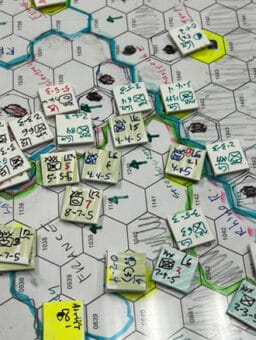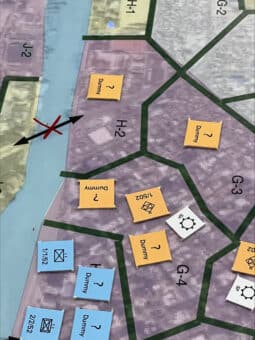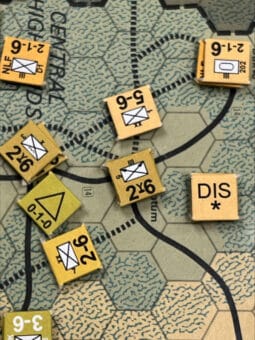Wargaming the Complexity Barrier
by Roger Mason
Introduction
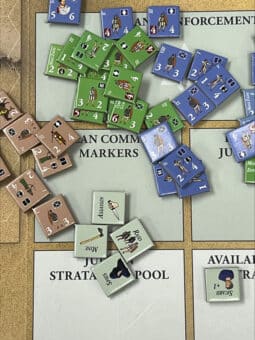 Is your wargame complex or just complicated? This is an old problem. From Arithmomachia (The Battle of Numbers) in the 11th century to wargaming asymmetric warfare, designers have sought to produce the most realistic model. The challenge has always been to capture the infinite elements and unpredictability of warfare. In “On War” Carl von Clausewitz observed, “Three quarters of the factors on which action in war is based are wrapped in a fog of greater or lesser uncertainty.”
Is your wargame complex or just complicated? This is an old problem. From Arithmomachia (The Battle of Numbers) in the 11th century to wargaming asymmetric warfare, designers have sought to produce the most realistic model. The challenge has always been to capture the infinite elements and unpredictability of warfare. In “On War” Carl von Clausewitz observed, “Three quarters of the factors on which action in war is based are wrapped in a fog of greater or lesser uncertainty.”
To pierce this fog designers have produced more and more complicated games. This is based on the belief that complicated games will capture the factors which make the vagaries of warfare knowable. As games have become more complicated the opposite appears to be true. The outcome of game complications becomes a challenge resembling entropy. The weight of the complications gradually reaches a point where modeling greater complexity becomes impossible. This point is the complexity barrier.
This article will explore games as systems and identify possible solutions to crossing the complexity barrier. The examples will contrast complicated versus complex games.
We will explore the science of systems, emergent behavior in games, and how they can factor into game design. We will evaluate the possibility that emergence can move games from merely complicated models to beyond the complexity barrier.
Games and Systems
In his study of applied theory for game design, Joris Dormans defines games as “Rule based artifacts designed to be experienced by one or more players in which they strive to achieve some sort of goal.” In this article we will explore a subset of games which is the conflict simulation or wargame. This subset requires a definition that reflects the unique nature of conflict, especially armed conflict.
Peter Perla observed that a wargame is “Any type of model or simulation, not involving actual military forces, in which the flow of events is affected by decisions made by players representing the opposite sides.” Can a wargame be considered a system?
One of the fathers of systems theory is Karl van Batalanffy. He said, “A system is the nature of their component elements and the relations or force between them.”
Bertalanffy, identified four elements of a system: output, process, inputs, and feedback.
Output represents the desired goal of the system. The process is the operation that transforms inputs to output. Inputs are the materials or resources that are transformed to output. Feedback provides information that controls the system. In a wargame the players control the elements of the game system.
 Complex Adaptive Systems
Complex Adaptive Systems
Is a wargame a complex system and is it capable of adaptation? A system is complex because of the interactions between its parts. Complex systems also have unique properties such as non-linearity, emergence, and feedback loops. So, wargames display each of these properties. What about adaptive systems?
Complex adaptive systems share the properties of complex systems but with an additional wrinkle. The system can respond to interactions then self-organize and adapt.
What about wargames? Do they respond and adapt. Conventional games are not self-adaptive but directed by players who are self-optimizing. The players rely on feedback to direct their decisions and actions. Wargames are complex systems but involve self-optimization instead of adaptation.
Complicated Versus Complex
In discussing wargames is “complicated” the same as “complex?” The two words sound very similar, but are actually are very different. In a complicated system the outcomes are deterministic. If you know the starting conditions you can predict the outcomes. In a complex system outcomes are non-deterministic and therefore non-linear. Knowing the starting conditions and the rules of the game will not allow you to predict the outcomes. In both types of games the outcomes are based on the relationships and interactions of agents in the game environment.
Complicating Elements
In wargames there are four common complicating elements. They are rules, modifiers, agents, and accounting. When combined they can present a game design that is so complicated that achieving complexity is impossible. Written rules are common in commercial games. The art of writing rules is not how many you can produce but how few you can employ with the same result. Professional games also have rules, but they rely on facilitators that provide real time control and direction of gameplay.
Modifiers are the elements that alter factors in the game. These factors can include the rules, the environment, and players actions. Modifiers allow designers to nuance the application of individual elements. The problem occurs when you approach having a modifier for everything. This adds to the complications of managing gameplay.
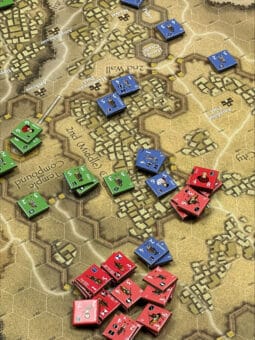
Complexity can occur with the interactions and relationships between agents. A complicating factor is the granularity of the game. A game with thousands of agents may be realistic but in practical terms is unmanageable.
Accounting involves tracking conditions in the game. This can provide a realistic picture of unit capabilities and strength. The more complicated the rules and modifiers combined with the number of agents the more difficult it is to track and account for the outcomes. At some point the net gain in realism is outweighed by the investment to account for the outcomes.
In terms of thermodynamics, entropy becomes insistent as a system begins to degrade and break down. The system eventually becomes dysfunctional. In a wargame, the accumulation of complicating factors limits the opportunity for modeling complexity. As ironic as it initially sounds, a game can begin to collapse under the weight of its complications.
The Complexity Barrier
A simple definition of the complexity barrier is when:
- The elements of the game become so complicated that determining outcomes, become impossible. As the complication level of the game increases predicting outcomes may be theoretically possible but gradually becomes impractical.
- Evaluating and manipulating greater complexity becomes impossible.
Game designers often add complicating elements hoping to capture complexity. Four common examples are the earlier-mentioned agents, rules, modifiers, and accounting. In a wargame the agents often represent individuals or units. These agents can be manipulated by players to achieve effects through combat or maneuver.
Rules guide and restrain the players in how they can manipulate their agents, how the environment may change, and how modifiers will work. Modifiers are conditions that alter or add to the rules. The final example of a complicating factor is accounting. Tracking conditions in the game is the need to account for changes in the game’s elements.
Here is an example. We are designing a wargame involving a single infantry battalion landing on Omaha Beach during the battle of Normandy. We want this to be as realistic and complex as possible. A typical infantry battalion of the period was 1,000 soldiers. The most realistic model would include all 1,000 soldiers as individual agents.
We develop rules for the soldiers’ movements and combat. We differentiate the soldiers by the types of weapons they carry from rifles to automatic weapons. Our goal is the most realistic and complex model, so we include modifiers for the strength, range, and effects of combining the weapons. We include modifiers for the effect of terrain types. Finally, we need a system to account for a variety of factors including casualties and logistics.
We have a highly accurate representation of a single infantry battalion in the battle of Normandy. It is very complicated but is it complex? It is complicated because there are so many agents whose actions are directed by rules and effected by modifiers. The game has accounting systems to track a variety of elements. Is this a complex game? The answer is no. It is a complicated game. Although it is theoretically possible to track potential outcomes, the sheer number of elements makes such tracking impossible.
In games where the design elements grow in complication the barrier between complicated and complex cannot be crossed. By adding more complications, the complexity barrier is not broken but continually pushed away. The result is an objective that is continually withdrawing and remains impassable. Is there a method to limit complications and still cross into complexity? The answer may be emergence.
Emergence: Crossing the Barrier
Emergence is an example of where less is more. Salen and Zimmerman observed that emergent systems are coupled, and context dependent. Coupled refers to the relationships between the elements of a system. Context dependent involves the situations and environment where these interactions occur.
A limited set of rules can generate unpredictable outcomes. The New England Complex Systems Institute states that emergence is the “existence or formation of collective behaviors. These behaviors are only possible by the interaction of individual elements”
A small number of dynamic elements can result in very complex outcomes.
Salan and Zimmerman noted that “In games, emergence arises through the interaction of the formal game system (rules) and the player’s decisions.” The emphasis of emergence is not on increasing the number of complicating elements but the relationship and interactions which result in unexpected outcomes.
Properties of Emergence
When a complex system has properties or behaviors that only appear as the result of the systems elements you have emergent properties. The properties include relationships, interactions, and leverage points.
Relationships
Emergence begins with relationships. The Oxford American Dictionary defines relationships as the way two groups behave towards one another. This behavior can lead to interactions. In wargames the origination point of relationships is the agent. The agent represents units that can be employed by the players.
The three primary relationships of agents include the environment in which the agents act, the rules governing their actions in the environment, and the agent’s resident system, i.e. the US Army. The environment includes elements of the game system including the terrain and the scale of the map. While rules dictate the types of actions the outcome of the rules may be unpredictable. Jeremy Campbell noted that, ”One can describe all the rules but not necessarily the product of the rules.”
There are also secondary relations such as modifiers, other agents, and peer systems.
Modifiers make small changes to the rules. These changes can be immediate to the current game turn or permanent to the remainder of the game. Other agent interactions include friendly and hostile agents. Finally, the agent may have a relationship to other peer systems i.e. abstracted units, the opponent.
Interactions
In wargames, interactions are points where rules, modifier results, and player decisions
Intersect. This is made possible by their relationships. Rules guide how the interactions occur. The modifiers make changes to the actions of the players.
The rules of the game, the modifiers of outcomes, the players actions, the game environment, and the sequence of play provide context. Context can cause additional interactions to occur and provides understanding to the game’s relationships and interactions. Context is the dynamic canvas where the game is played and the interactions occur.
 Leverage Points
Leverage Points
Leverage points are places in games where interactions occur and uncertainty increases. Leverage points also occur where systems overlap, when the potential for risk increases, and/or uncertainty escalates. There are two types of leverage points, direct and indirect.
In commercial games the players want opportunities to optimize their position through tactics or strategy. A designer’s objective is to provide meaningful game play. Direct leverage points work well by providing opportunities to manipulate conditions and potential outcomes. This is not the case for professional wargamers. Their objective is to develop the most accurate model providing a basis for evaluation and analysis. In professional games, Indirect leverage points involve the unique aspects of a particular model. Professional designers employ leverage points as part of the design to encourage unpredicted outcomes.
Flow of Emergence

there are elements that are designed to be coupled such as independent units, maneuver, combat and logistics. They provide a model that allows the simulation of military operations. Each of these elements is coupled meaning they are designed to interact with one another. This is further complicated by adding an adversary with the same elements providing new relationships and interactions.
These relationships and the resulting interactions can result in a cumulative sequence of events or flow. Interactions lead to new elements and relationships. This is compounded by the context. The context may be the environment, combat strength, or movement. When you overlay familiar interactions in a different context it is possible to stimulate new outcomes. As these interactions occur it is essential to monitor and evaluate them. This is the value of feedback loops.
Feedback Loops
If our design goal is introducing complexity through emergence, how do we evaluate this? Complexity and emergence can be evaluated through feedback loops. Feedback loops go back to Norbert Weiner and his theory of Cybernetics. Authors Kinza Yasar and Laura Fitzgibbons define feedback loops as “A systems process that uses some or all of the system’s output as input for future operations.” Feedback provides understanding for the emergence of elements that increase complexity.
In Joris Darmon’s book Engineering Emergence: Applied theory for game design the author proposes a seven-step method for evaluating complexity and emergence in games. The goal is to stimulate uncertainty by exploring uncertain relationships and interactions. Dorman’s feedback process provides a method for evaluating these outcomes.
Type: There are different types of feedback. Positive feedback amplifies differences and destabilizes the game. Negative feedback dampens differences and stabilizes the game.
Effect: Constructive effects aid players while destructive effects hinder them.
Investment: High investment means many resources are needed to activate feedback.
With low investment fewer resources are required.
Return: With high returns the net gain is significant. With lower returns the net gain is less. Insufficient returns mean the net gain does not outweigh the investment.
Speed: Immediate speed means that feedback appears as the complexity emerges.
Fast speed means there is a slight delay of the feedback. Slow speed means the feedback results appear gradually.
Range: Short range feedback is limited to the immediate area where the interactions occur. At long range, the feedback can occur indirectly.
Durability: This refers to the ability to maintain a specific feedback loop. None means the feedback works only once. Limited indicates the feedback will be available for a short period of time. Extended feedback occurs over a longer period of time and permanent feedback is always available.
Determinability
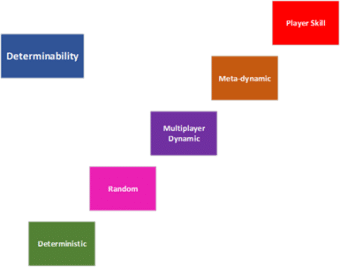
- Determinism: Depending on the game state the game mechanics will act the same.
- Randomness: The feedback loop can be affected by random factors.
- Multiplayer-Dynamics: the impact of the game systems is affected by the interaction of the players.
- Meta-Dynamic: Rule based outcomes are affected by the interaction between players.
- Player-Skill: Game outcomes are affected by the skill of the players.
Practical Application of Emergence
We have discussed emergence and feedback but how does this work in a game?
Back to Normandy
In our earlier example we discussed a D-Day game employing 1,000 agents to represent one battalion. The granularity was very fine with a healthy dose of rules, and modifiers to direct the action. The conclusion was it was impossible to predict potential outcomes because of the impracticality of managing the agents. So, what can be done?
There are six steps.
First, reduce the granularity. Instead of individual soldiers we will employ companies. A regiment has three battalions with five companies per battalion. Instead of 1,000 individual agents we have 15 agents (or units) representing 3,000. A total of three regiments would be 9,000 soldiers represented by 45 agent/soldiers.
In the complicated approach the various individual weapons systems are modeled along with the effect of their joint employment. This can be simplified by abstracting them with the addition of a heavy weapons company as an agent. The modifiers were reorganized with many being eliminated and command and control being added. A few simple modifiers like combining heavy weapons companies on a target were added. Each battalion has a headquarters company. To function the battalion must be within a defined range of the headquarters company.
The terrain effects were retained. Finally, accounting was eliminated by giving units two sides. The second side at half strength represents a unit that has taken losses or is out of range of its headquarters company. This provides an improved visual aesthetic where the condition of individual units can be immediately determined by the player.
The elements of the game have been greatly simplified. What are the potential locations where emergence may occur? The most obvious is combat with the enemy forces. Maneuver is varied across the terrain effects. A battalion that loses its headquarters immediately drops to half strength and movement.
Salen and Zimmerman observed that emergence in a game is context dependent. The drop in granularity means the American player can control and move their forces. They will be able to scan the map and quickly determine the condition of their forces. The 45 agents or company pieces will be interacting across a variety of terrains. The players will be moving their agents or units and interacting with the enemy forces. Command and control is essential but tenuous.
These elements represent forces, organization, actions, and a dynamic environment. Along with these elements are the secondary effects of determinability. Random chance, multiplayer dynamics, and player skill further impact results. As these elements interact what emerges are unpredictable outcomes. This emergence reveals relationships and interactions that would not be obvious in the 1,000 agent ant hive approach.
Lenses of Emergence

Emergence in a game can be approached as a cumulative process. There are three steps which are relationships and interactions, feedback, and determinability. Each provides a lens gradually revealing more information. Relationships and interactions can be used as a focal point for exposing the initial layers of complexity. Feedback provides information about outcomes and their impact on the agents and their environment. Determinability offers the external factors that can impact outcomes. Just as in astronomy, the cumulative effect reveals more information.
For commercial designers these lenses offer more meaningful gameplay. For professional wargame designers the lenses provide a deeper level of analysis revealing otherwise unknown relationships and interactions.
Limits of Complexity
Like any formula there are limits to complexity. Salen and Zimmerman observed, “Meaningful play in a game emerges from the relationship between player action and systems outcome.” Meaningful play requires maintaining a balance of complexity and scope of inquiry. The scope of inquiry involves the relationships you wish to investigate. If the game becomes too complex and the scope of inquiry is too wide the results are unmanageable.
As the elements in the game become increasingly dynamic the states of the agents and their interactions become more random. This is often indicated by a shift representing the tipping point. The emerging complexity requires more and more management with fewer usable outcomes. Usable outcomes are not predictable but the results of the relationships and interactions that caused them provide understanding.
Per Bak commented that “A complex system cannot be too orderly where the system has the same behavior from moment to moment. At the same time, a system can’t be completely chaotic, where each moment of the system only randomly corresponds to the next.” The result is the loss of practical complexity and the inevitable slide into chaos.
The Final Outcome

In Emergence: From chaos to order John Holland observes “We can contemplate emergence if we turn to a seemingly unrelated arena, that of board games. Agreement on a few rules gives rise to extraordinarily complex games.“ The secret for wargame designers is employing emergence to cross the complexity barrier and exploring the possibilities of complexity. All of this while avoiding an attractive edge that leads to a black hole.
 Sources
Sources
This blog article is not formatted as a peer reviewed academic journal article. It is still essential to give credit to the sources that I consulted. All the books listed are in print and available from a variety of sources. For the online sources I have included the link.
For those hearty souls interested in pursuing this topic I have included a brief description of each source.
- Per Bak: How Nature Works: The science of self-organization
Bak’s book is a study of self-organizing criticality. I found it useful for his description of complexity in systems. - Jeremy Campbell: Grammatical Man: Information, entropy, language, and life.
Campbell is interested in information theory. An important adjunct is the role complexity plays. - Karl van Batalanffy: General Systems Theory: Foundations, developments, and applications.
Batalanffy was one of the earliest developers of systems theory. - Carl von Clausewitz: On War
This book was published in 1832 but the principles about human conflict are still valid. - Joris Dormans Emergence: Applied theory for game design
Joris Dormans is a faculty member at the University of the Netherlands. This is an excellent book for wargame designers. - New England Complex Systems Institute
NECSI is a great resource for information on complexity. https://necsi.edu/John Holland: Emergence: From chaos to complexity
John Holland was a founder of the Santa Fe Institute.
- Neil Johnson: Simply Complexity: A clear guide to complexity theory
This is a useful book to introduce the topic of complexity. - Peter Perla: The Art of Wargaming 2nd Edition
This is a classic for anyone interested in wargames. The concepts have served as the foundation for research and many articles and books about wargaming. - Salen and Zimmerman: Rules of Play
This book is one of the most comprehensive volumes on game design available. The authors have an excellent description of complexity and emergence in games. - Norbert Weiner: Cybernetics, or control and communications in the animal and the machine
This book is a classic in study of systems and feedback loops. It is heavy reading because the author goes off in many other directions (time, information theory etc) . - Kinza Yasar and Laura Fitzgibbons: Tech Talk: The definition of feedback loops
This article provides a succinct explanation of feedback loops. https://www.techtarget.com/searchitchannel/definition/feedback-loop

